This month’s just concluded Outdoor Retailer show, marking the event’s return to Salt Lake City after five years, highlighted a good representation of creative entrepreneurship and collaborations. Even though many people are not avid outdoors recreation enthusiasts, the show featured many ingenious, artistic, and sophisticated product lines. These innovations suggest that the market tent for the outdoor sector can be expanded to accommodate virtually any lifestyle and aspiration. Outdoor Retailer will hold its next show June 19-21 at Salt Palace Convention Center. The Utah Review highlights many of these examples.
PAKA APPAREL
Kris Cody, a paragon of bootstrapping for budding entrepreneurs, transformed an unforgettable image of a hand-woven alpaca sweater he had purchased from a Quechua woman eight years back during a trip through Peru to Cusco into Paka Apparel. The company also won an Innovation Award at this month’s Outdoor Retailer Show in Salt Lake City. The award was given for Paka’s patent-pending PAKAFILL® insulation, which has consistently tested as staying warmer and drier than customary synthetics in lightweight puffers.
Cody traveled through South America during his gap year in 2015 before he began his University of Virginia neuroscience studies. Cody found that his sweater, handwoven by Quechua artisans, felt softer than cashmere, merino, and other sweaters he had worn back home.

Cody was enthralled by the compliments and made a bold move to make a name for himself as an entrepreneur. Completing his freshman year, he returned to Cusco, wondering if he could turn his dream of bringing traditionally-made Incan apparel to the U.S. “I bought a ticket for a one-way flight,” he says in an interview with The Utah Review. His network quickly grew, with many of the weavers being women. As he explained in a UVA feature from 2017, “Last summer it was just a dream. It was the first batch of sweaters I designed. Every single morning, I’d go over and meet with the Chaskis, a family of weavers outside Cusco. We’d cook eggs together and work on prototypes. It was really a shared vision.”
Along with his prototypes for apparel, which he created using the Quechua craftsmen’s input, he discovered that the craft wasn’t just an anthropological language for indigenous culture expression or preservation but also a means of supporting the economic and education empowerment of weavers in Peru and alpaqueros from the Andean highlands. These families manage a small number of alpacas. They typically oversee between 60-90. Cody says that while four sheep are required to cut enough fleece for one sweater, one alpaca is capable of providing enough for up to four. Alpacas must also be sheared once a year. This protects them from overheating and immobilization, as well as parasitic infections.
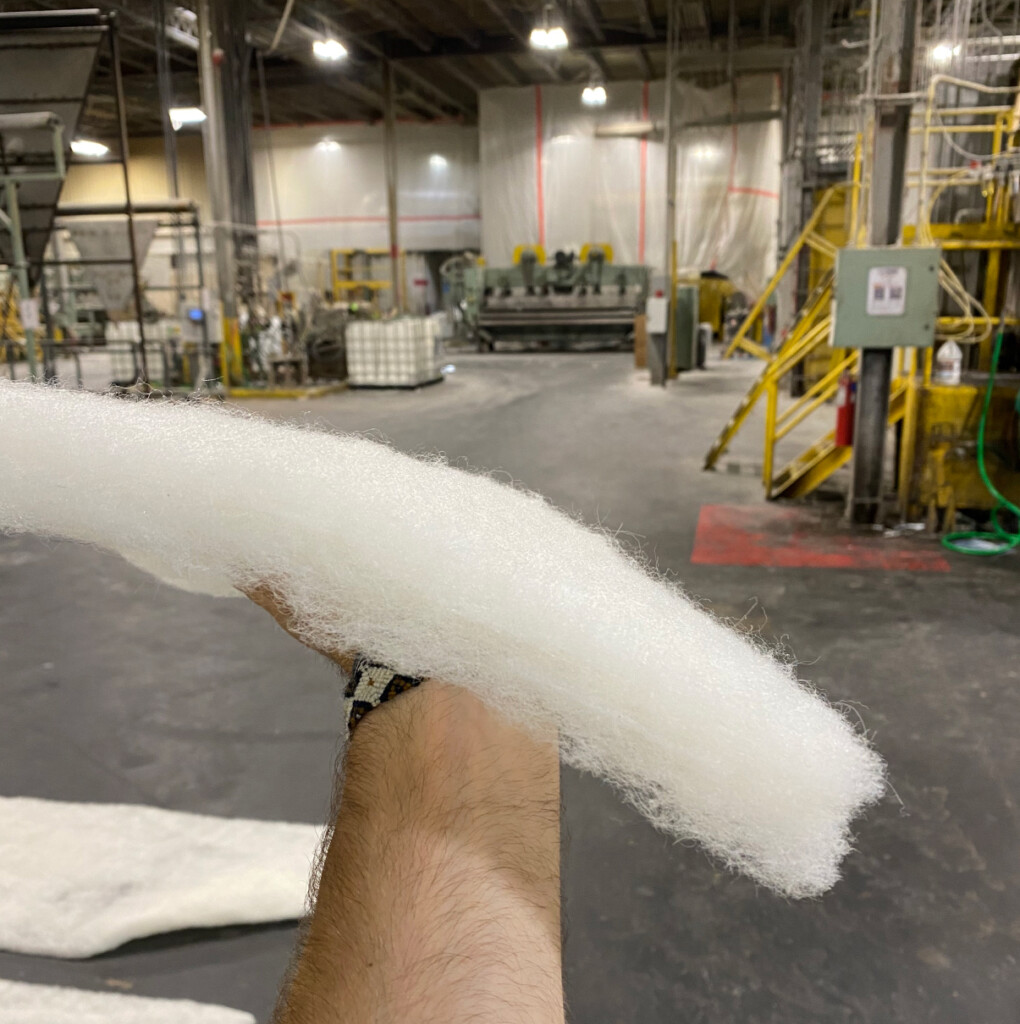
Cody was back in the U.S. when he created a website with his friends that featured the very first Paka sweaters. He won a spot in UVA’s i.Lab summer incubator to guide the founding of the company. He understood the power of social media, and the influence of prominent people like many other millennials. Chance the Rapper, Chase Josey from the United States snowboard team and Leah Dawson were among them. With a Kickstarter campaign that was immediately successful, the company was officially launched in 2017. He also completed his neuroscience degree.
Cody also created Paka with the intention of providing direct economic return to the weavers. They sign every piece made. Over 100 Quechua women work in Paka and receive a salary that is four times the average family income standard. Six awards were made to Peruvian women for full-ride expenses as part of the company’s university scholarship program. One of the board directors is Nilda Callañaupa Alvarez, a Quechua weaver who established the Center for Traditional Textiles of Cusco more than a quarter of a century ago. Cody says that it was important to ensure the weavers have a voice in ensuring the cultural integrity of Paka’s apparel and products and Alvarez is overseeing those efforts.
Cody’s scientific background and his experiences in the Andean Highlands have expanded into other products for the company. Focusing on the challenge of making products that avoid the micro plastics contamination problem, the company now offers lightweight puffers which are packed with alpaca fiber — the award-winning PAKAFILL® insulation — encased in a water-resistant shell made with certified recycled polymer. The new puffers, like all other Paka apparel products, have QR codes that allow you to track back to the source.
LIMBER BOWS
Handcrafted products signaled a definite trend at this month’s show, particularly for the ingenious process that led to their creation. John Hermanson is a Bozeman-based musician, who also plays the violin in Storyhill folk duo. This leads to Limber Bows, which is a multi-purpose, versatile set of trekking poles. He began by creating his own garage, and interest in the invention has steadily grown.
Any musician who plays a stringed instrument with a bow can relate to the underlying physics and benefits of Hermanson’s invention. The poles are made up of seven layers of different materials. They include layers of wood such as ash and hickory, and layers of fiberglass and carbon fibre.
Hermanson said that while navigating North Cascades’ steepest ridges, he got obsessed. His goal was to create poles that could support his weight and be flexible enough for him to maneuver through rough terrain without compromising the endurance required to hike. The poles worked well for hiking up to 20 miles. “I could feel my oxygen levels were better and even at the end of a long hike, I feel like I am full of energy,” he adds, in an interview with The Utah Review. Hermanson added the right punctuation to the message, since he was wearing Skinners Footwear’s smartly designed pair of socks shoes (also featured in this roundup).
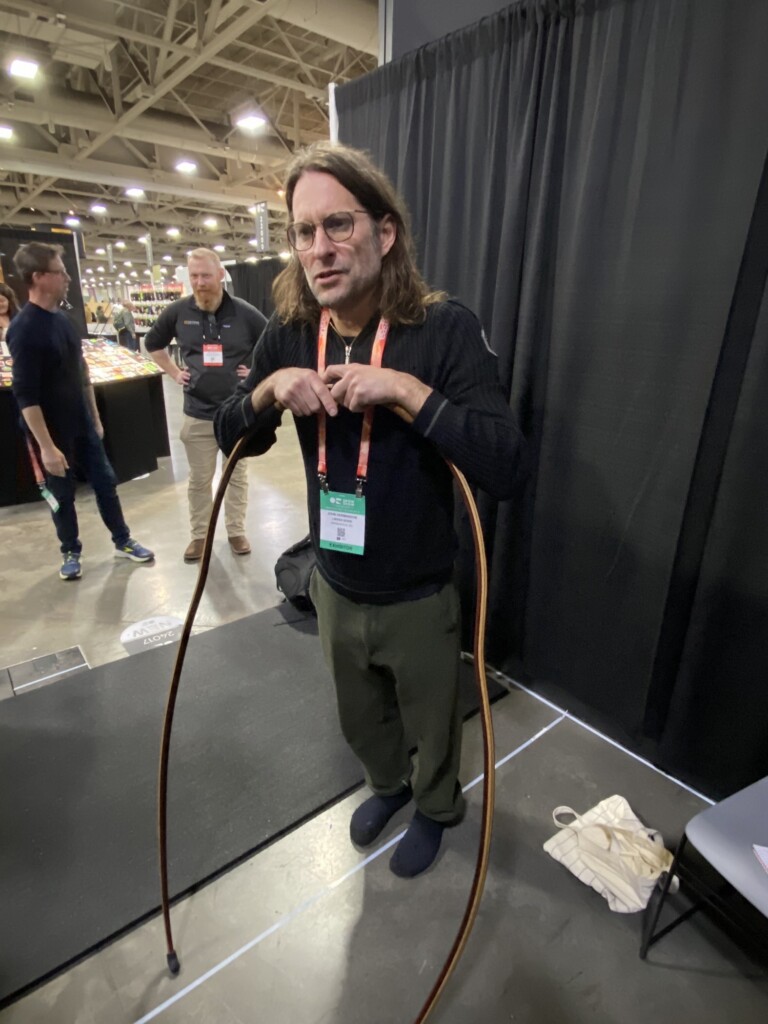
On his website, he wrote about Limber Bows’ core importance.
It is still in my possession, just 5 inches from the ash. The Wolverine Creek fire in 2015 burned it into an attractive semicircle. It travels with me in my VW bus everywhere I go and works great as a frame to twist a string of USB LED lights around so I don’t have to worry about my dome light draining the battery. It also sits inside the “hot box” with every bow I build, for the final stage of the 24 hour curing process. It’s a small ritual I perform to recognize the lineage every new bow belongs to, a reminder that each new prototype is the result of lessons learned from all its predecessors, reaching all the way back to this found original.
Consider how a skilled violinist bows to make the perfect sound. They also need to consider the proper speed, force, and position of their bow. Likewise, the poles’ recurved bow design, which stand at a person’s shoulder height, will give the user the benefit of more limber movement and spring in their step. This increases the endurance of outdoor enthusiasts and hikers. To wit: Hermanson’s father has been chair of the physics department at Montana State University.

Hermanson said that he tested prototypes in order to determine the ideal design. “My father says that the bows allow him to exercise three times longer than before,” he adds. Although he originally designed the product to be used by hikers or trekkers who traverse steep terrain and rugged terrain, the bows can also be used for yoga and other purposes, such as for those in rehabilitation and physical therapy.
Hermanson wants to hear from people who purchased these bows. A trail yoga enthusiast from St. Paul, Minnesota shared her experiences about using them on a hike through a steep ravine in Michigan: “I can feel the bows vibrating and moving in sync with the flex and release of my muscles. They help me keep my stride rhythmic and steady as I anticipate the terrain. And when I stop to catch my breath, I lean back on them to release my spine and look at the sky.” She added that the sensation was like surfing waves, practicing yoga or playing a bass guitar.
ALLIED FEATHER + DOUBLE AND FUZE BIOTECH
Allied Feather + Down is a California family-owned company that has been leading the way in sustainability and traceability. Two of the most important programs for quality assurance in outdoor recreation were developed by Allied Feather + Down: Track My Down and Responsible Down Standard (RDS).
Allied Feather + Down, in collaboration with FUZE Biotech, won the Innovation Award for ExpeDRY. This insulation is widely recognized as being chemical-free and fast drying.
It is noteworthy that FUZE is collaborating with FUZE in West Valley City (UT). FUZE is a company that has extensively researched and developed a free-of-chemicals technology which can be applied on all surfaces of fabrics to combat bacteria, virus, and pathogen contact. One million yards can be treated with a 5-gallon jug of ExpeDRY. It will virtually eliminate any side effects that could be harmful to the person or the natural environment.
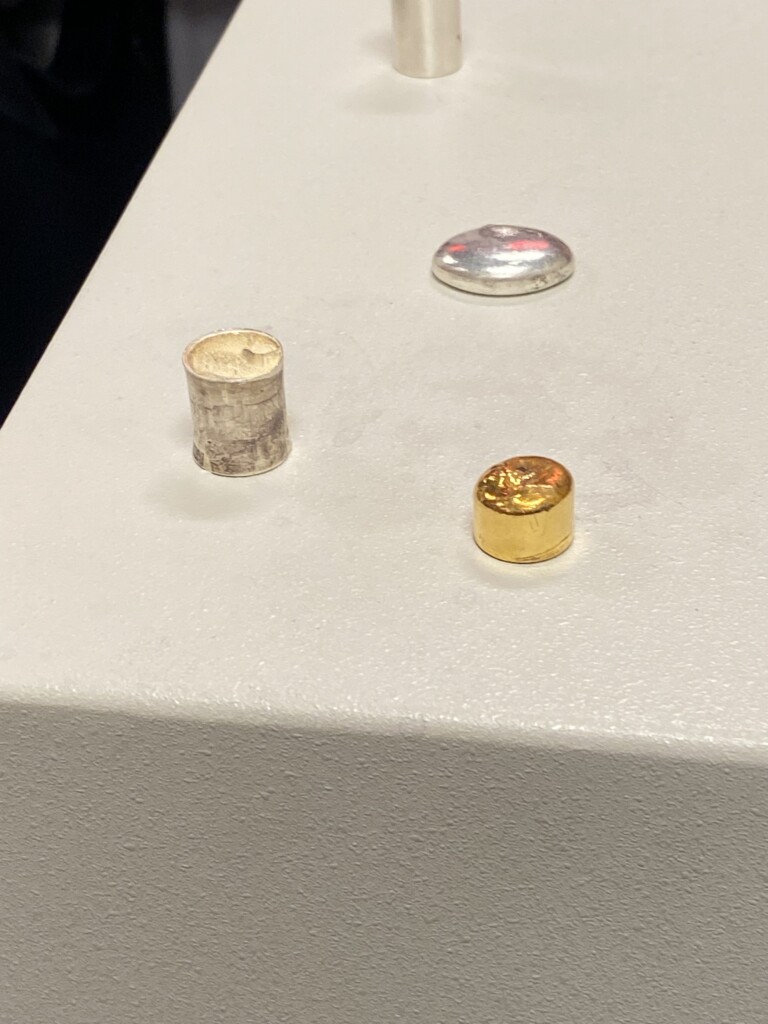
Unlike other manifestations of nanotechnology that have occasionally failed to deliver sustainable results, FUZE employs a high-energy method to create nanoparticles specifically for their purposes. Researchers have discovered that nanoparticles are not ionic and in FUZE’s lab work, it has been discovered that these smallest of particles also exhibit anti-microbial features.
Visitors were able to see the ExpeDRY process at work in the FUZE facility. They also got an update on the progress of a topical treatment for cystic fibrosis. This is currently being evaluated by the U.S. Food and Drug Administration. The company started the project with supporting grants from the Cystic Fibrosis Foundation, the University of Washington and a children’s hospital in Seattle to see if the technology would be effective in killing pathogens, especially those connected to cystic fibrosis.
This discussion led to the creation of ExpeDRY. Initial research revealed that a treatment for quality fabrics would give anti-microbial characteristics that could withstand many washes. Initial prototypes used silver-gold nanoparticles that had no adverse effect on humans or the environment. Then, scientists discovered permanently-bonded nanoparticles of gold were very effective in achieving the desired results. Thus, the gold nanoparticles set up an electro-static barrier, which enhances the hydrophobic characteristics and interacts with water’s hydrogen bonds. The water droplets can then be removed from the clothing before they saturate it. This prevents humidity from creating additional droplets.
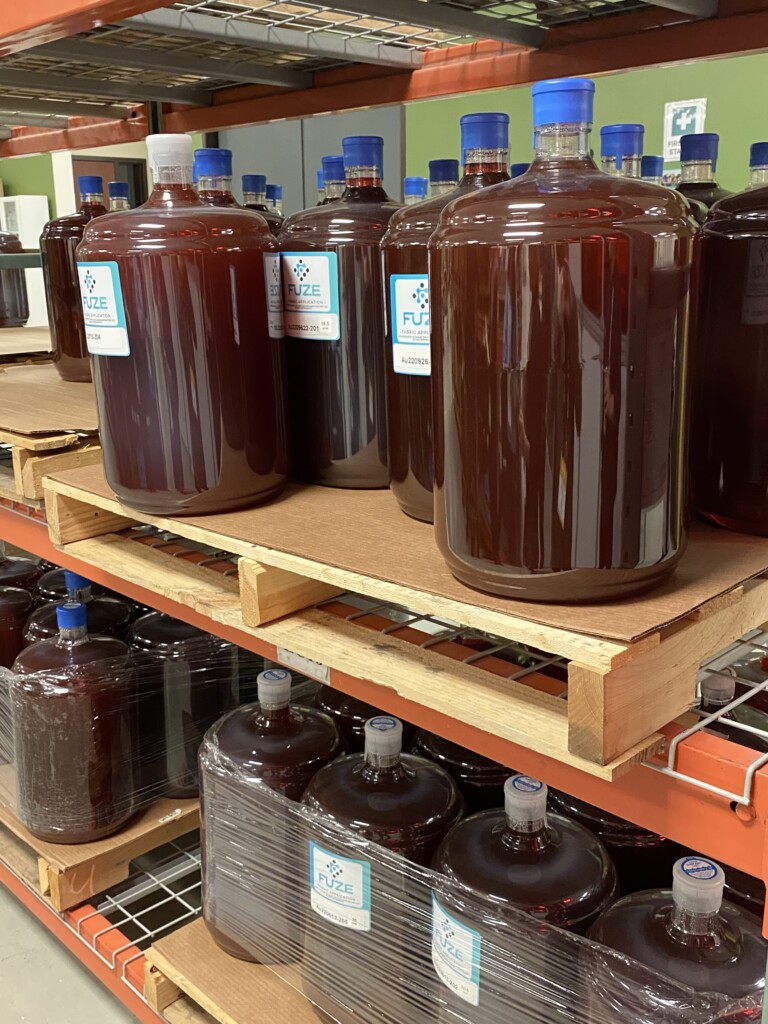
FUZE Biotech and Allied Feather+Dpwn ExpeDRY.
The down material cluster makes drying significantly faster for wet-weather workers. Science has shown that the gold bonded nanoparticles increase water evaporation without the need for heat (a clothes dryer). The applied water-resistant treatment for down functions like a hydrophobic solution, which lets water bead, allowing the garment to stay dryer for longer. However, conventional methods are not as effective in drying fabrics once they are saturated. ExpeDRY’s tests have replicated the following results consistently: the larger evaporation rate outweighs the benefits of conventional fabric treatments and treated garments dry nearly twice as fast as those saturated with other treatments
It could have far-reaching implications, going beyond sports performance and outdoor recreation to linen and laundry services in large hotels and resorts as well hospitals and universities.
Daniel Uretsky (president of Allied Feather + Down) made a prepared statement highlighting the partnership with FUZE. “Using their incredibly knowledgeable and unique approach to innovation and dedication to sustainability, we are finally able to realize our quick-drying product,” he said. “This is a potential game changer for the European market that relies on condenser dryers, which have always made down insulation difficult to care for and dry properly.”
Customers can expect to see Artilect, Jack Wolfskin, and other brands of outdoor recreation products, especially in the later part of this year.

SKINNERS FOOTWEAR
Skinners Footwear is based in Czech Republic and has been a strong player in Europe’s minimal footwear market. But, the Outdoor Retailer show this month was the ideal opportunity for early adopters in the North American market to be introduced to the company’s newest lines of sock shoes and sneakers. The shoes replicate the feeling of barefoot that many outdoor enthusiasts, such as runners, hikers and trekkers, are looking for. In fact, as mentioned earlier, Limber Bows’ John Hermanson sported a pair of Skinners’ sock shoes at his exhibitor’s booth.
Skinners footwear offers a simple elegance while providing effective protection. MichalPresse, chief market officer of Skinners, stated in an interview that quality is the main focus, without losing sight of the more minimalistic aspects. The footwear is made from only 13 materials, which increases its durability and withstands outdoor activities. “No gluing. No stitching,” he says. “Our focus has shifted from the objective of the individual adapting to the shoe to the more satisfying outcome of the shoe adapting to the individual’s needs. In other words, it’s feet-first design.”
The sock shoe’s features include improved moisture wicking capacity, so feet will stay dry as well. Ultra-thin, polymer sole layers measuring only a tenth inch thick have been engineered to last up to 500 miles. The use of synthetic and natural fibers are compounded to fit to anyone’s feet.
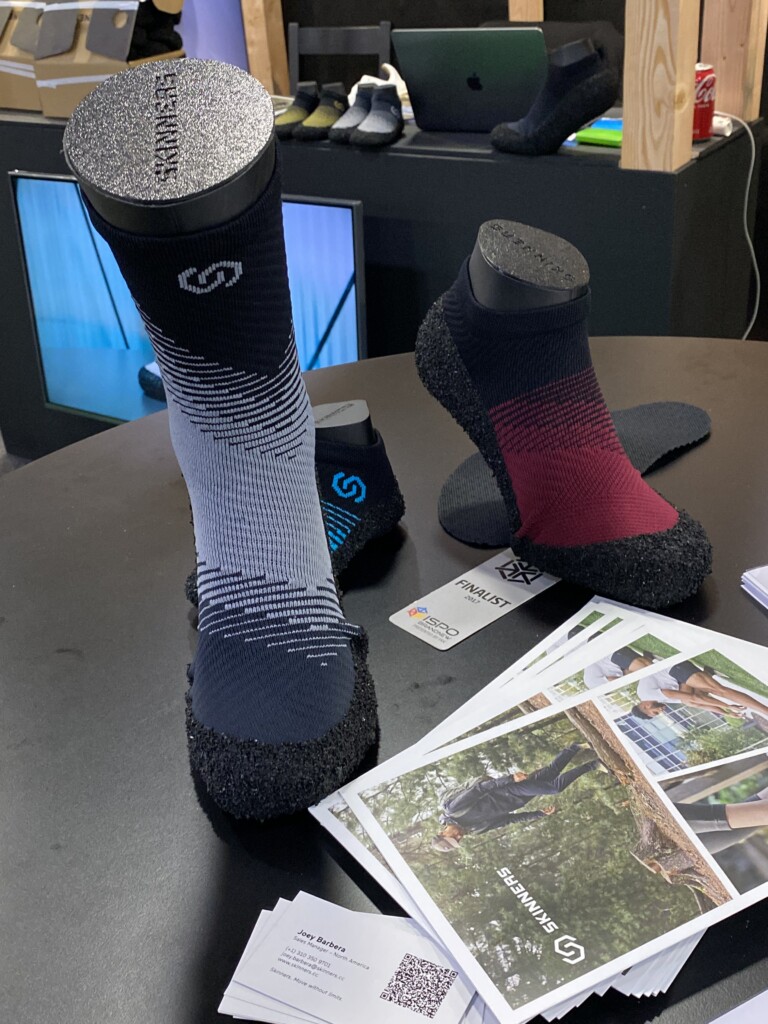
Skinners Footwear already has more than 700,000. pairs sold in over 100 countries within six years. This makes it a very positive move to enter North America. The Outdoor Retailer show became a showcase for two of the company’s newest product lines: the Compression 2.0 and Walker series. Walker’s sneakers have a competitive price, are comparable in quality or even lower than many other North American brands. The Walker sneakers’ minimalistic and stylish design fits perfectly in the customer equation. The shoes are made with Italian leather and a zero-drop flexible rubber sole. Presse says that the toe box should be left with enough room for toes to move in every step. The soles are constructed so that the movement then allows an individual’s muscles and tendons to open up naturally, which is optimal for leveraging the benefits of physical activity and exercise, indoors or outdoors.
Presse says that zero-waste technology requires eco-conscious manufacturing. These polymers come from Sweden, and the fibres and leathers are made in Italy.
GRAND TRUNK
After moving from Chicago in 2020, Grand Trunk now operates in Utah. It is in its third decade. In the couple of years since it moved to Utah, as Paul Asay explains in an interview with The Utah Review, the company – which produces product lines of hammocks, chairs, stools, blankets, pillows and miscellaneous accessories for outdoor recreation – has added 10 items. The company has also expanded its design options and colors to meet a wider range of styles, lifestyles and wants.
And, as with many of the exhibitors at the Outdoor Retailer show, Grand Trunk used its venue to showcase products, which could suit everyone’s preference, regardless of how intense or casual their preferred form of outdoor recreation might be. For example, the chairs and stools are small and foldable so that they fit into any car trunk or passenger vehicle. These chairs are great for parades and soccer games. The Evolution Hammock is for those who shudder at the idea of setting up a tent outdoors for sleeping or relaxation, as well as for anyone else that might be interested. Asay states that the hammock can be used as a sleeping bag and is a hammock. Baffled insulation is added to the hammock, which keeps it warm in colder temperatures. Asay claims that the hammock is as comfortable and appealing as a cozy sleeping bag. This hammock weighs only six pounds, so it can be easily transported in any vehicle.

Grand Trunk has also introduced Color Block Collections, which offer a variety of colors and patterns for its hammocks. One of these is inspired by Bauhaus design and it’s a stunning green design. Other limited-edition offerings include Ugly Sweater and Flamingo print.
Asay states that all products are covered by a lifetime warranty. Durability is critical for gear quality and it is Grand Trunk’s objective to ensure that customers are motivated to keep their products and to avoid thinking about tossing them when they ultimately end up in the landfill.

SHWOOD EYEWEAR
In celebrating some of the nation’s national parks, Shwood Eyewear recently introduced the CAMP collection of sunglasses, in which a portion of the proceeds (5%) is given directly to the national park featured in the respective product. The collection includes Arches National Park, Joshua Tree, Glacier, and Crater lake. The Crag product for Arches includes clay and walnut components, along with a chamois cloth featuring a line drawing of one of the park’s iconic images.
Wood inlays add a stylish touch to the bioplastic-based eyewear. You will also find polarized lenses which reduce the glare as well as spring hinges that keep your glasses in place even while you’re doing most of the active recreational activities. There are adjustable temple tips and adjustable tips. These glasses can be purchased for as low as $69.99 per pair or $99.99 each.